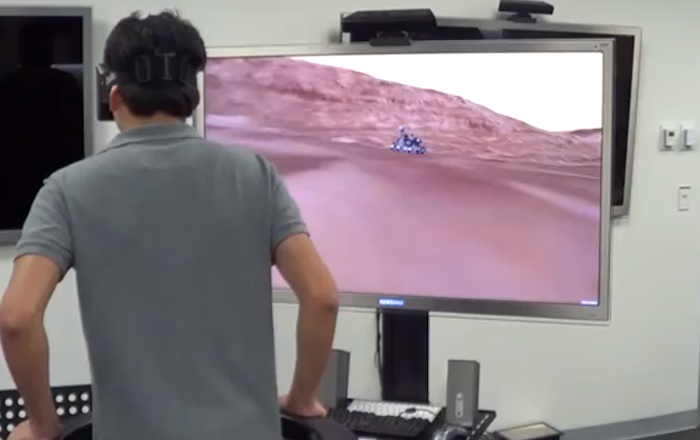Oculus Rift, Virtuix Omni Used To "Walk" on Mars

JPL used the Oculus Rift and Virtuix Omni to take an on-foot tour of Mars.
Engadget reports that NASA's Jet Propulsion Laboratory was intrigued by the Oculus Rift head-mounted display when they first saw it last year at PAX, enough so that they grabbed a developer kit as soon as it became available. Once it arrived, the team combined Rift with a stereoscopic 360-degree panorama of Mars obtained from Curiosity, sat back in their seat, and took a stationary, virtual trip to the red planet.
But JPL wanted to take the experience even further. After all, demos running on Oculus Rift allowed the viewer to move through virtual terrain using a gamepad – we did that back at CES 2013 in January, taking a stroll through a modified version of Epic Citadel. Thus the team decided to add terrain imagery captured from satellites which in turn allowed them to "walk" across Mars at up to 25 centimeters per pixel using an Xbox controller.
"However, we thought it'd be great if we could literally 'walk' on the terrain," said Human Interfaces Engineer Victor Luo.
In early June, the JPL team caught wind of a company called Virtuix who was in town showing off its Omni "treadmill" during E3 2013. This device doesn't have any moving components, but consists of a rounded concave platform connected to a stand for providing support. Users wear special shoes to "walk" in any direction, and the movements, for now, are tracked by Kinect for Windows. We took the Virtuix Omni for a spin using the Oculus Rift and Half-Life 2.
Luo said they invited Virtuix to the JPL headquarters, hooked the Omni up to their virtual Mars setup, and found themselves wandering around Mars on foot for the very first time – no space suit or 6-month-long psychosis-causing trips necessary.
After that, the team decided to move away from Mars and attempt to visit something more closer to home: the International Space Station. They mapped the interior of the ISS, connected the Oculus Rift, and began floating through the station's virtual rounded tubes. "There's no real up or down in the space station. You get this feeling of weightlessness when you're looking up or down," he told Engadget.
Get the Space.com Newsletter
Breaking space news, the latest updates on rocket launches, skywatching events and more!
Luo said that virtual reality tools like the Oculus Rift and the Virtuix Omni (obviously not used for the ISS demo) can better immerse scientists and researchers in the environment. "Instead of looking at a two-dimensional image, they would know [for example] that the rock is to the left of the rover," he said. "They can collaboratively look at the space and say, hey, we should go up to the right of the canyon. It makes sense to use something like this for a more immersive and more natural experience."
Given that the Rift was built with gamers with set budgets in mind, it's currently limited in regards to applications like space exploration. Luo said he'd like to see more sensors built into it, giving the HMD more capabilities and exploration possibilities. "Obviously it's early days yet," he said.
JPL published the video below just this week. It was recorded over the span of several months showing the team's progression from the first Mars experiment to floating around the ISS.
Source: Engadget
This story was provided by Tom's Guide, a sister site to SPACE.com.
Join our Space Forums to keep talking space on the latest missions, night sky and more! And if you have a news tip, correction or comment, let us know at: community@space.com.









